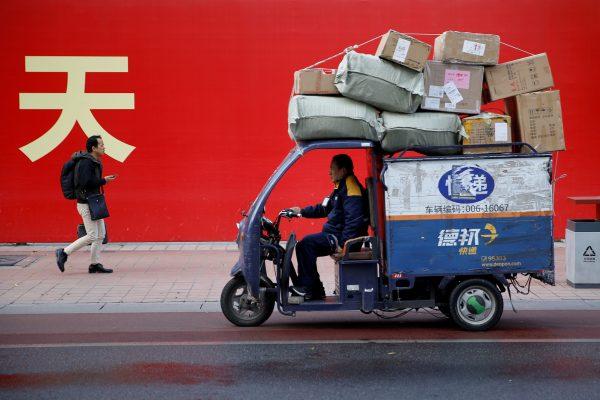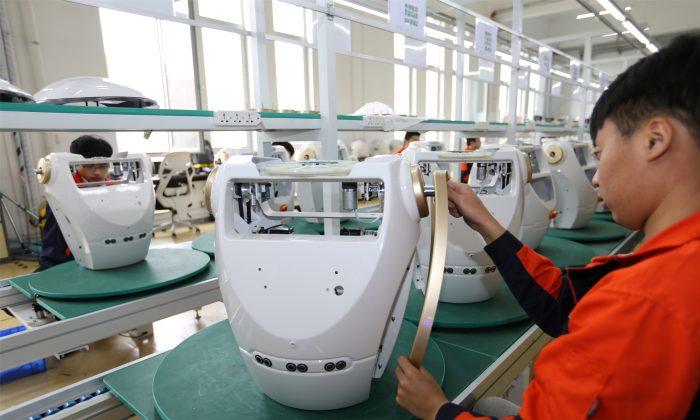BEIJING—Factory activity in China expanded for a second straight month in April but at a much slower pace than expected, an official survey showed on April 30, suggesting the economy is still struggling for traction despite a flurry of support measures.
The unexpected loss of momentum at the start of the second quarter followed upbeat data in March, which had raised hopes among global investors that the world’s second-largest economy was getting back on firmer footing.
A private business survey on April 30 also pointed to a loss of momentum, confounding expectations for a pick-up, with factories starting to shed jobs again after adding staff in March for the first time in years.
The weak manufacturing readings, along with softer construction growth, could stoke debate over how much more stimulus China needs to generate a sustainable recovery, without risking a rapid jump in debt.
The official Purchasing Managers’ Index (PMI) for manufacturing fell to 50.1 in April from March’s reading of 50.5, which was the first expansion in four months, data from the statistics bureau showed.
It hovered just above the neutral 50-point mark which separates expansion from contraction on a monthly basis. Analysts surveyed by Reuters had forecast the PMI to match March’s 50.5.
“For now, the official PMIs suggest that Q2 got off to a weaker start and reinforce our view that there are still some downside risks to near-term activity,” Julian Evans-Pritchard, senior China economist at Capital Economics, said in a research note.
Shares across much of Asia fell after the release of the data, while the Chinese yuan and the Australian dollar wilted. China’s slowdown has weighed heavily on exports of many of its trading partners and sales of multinational firms, from Apple to industrial conglomerate 3M.
While the official factory survey disappointed on the growth front, it didn’t show a marked deterioration in business conditions, either. Output expanded at a slower but still moderate pace, while growth in new orders eased only slightly.
Some analysts had expected a pullback in the PMIs, arguing that March’s more upbeat readings were likely due in part to one-off factors, such as changes in production and purchasing patterns ahead of a cut in value-added tax rates on April 1.
A spokesperson for the statistics bureau said earlier this month that many firms had brought forward purchases of input materials ahead of the tax change in order to increase their tax deductions. Indeed, a PMI sub-index for inventories of raw materials retreated significantly from March’s seven-month high.
A gauge of construction activity fell to 60.1 from 61.7 in March, still solid but possibly indicating that the Chinese regime’s infrastructure push may be losing steam, despite a burst of bond issuance and new bank lending at the start of the year, analysts said.
To counter the slowdown, Beijing has ramped up fiscal stimulus this year, unveiling tax and fee cuts amounting to 2 trillion yuan ($297 billion) to ease burdens on firms, while allowing local governments to issue 2.15 trillion yuan of special bonds to fund infrastructure projects.
Analysts have cautioned that it will take time for those measures to fully kick in, with most not expecting the economy to convincingly stabilize until around mid-year.
Another official survey on April 30 showed growth in China’s services industry also cooled in April, adding to uncertainty over demand in its economy.

The official non-manufacturing Purchasing Managers’ Index (PMI) fell to 54.3 in April from 54.8 in March, but stayed well above the 50-point mark that separates growth from contraction.
Services account for more than half of China’s economy, and rising wages have increased Chinese consumers’ spending power. But the sector softened late last year along with a slowdown in the broader economy.
Eyes on Trade Deal
While new factory orders remained sluggish, there were some encouraging signs on the export front.The official index for export orders continued to contract, but hit its highest level in eight months, as optimism grows that Beijing and Washington will reach a trade deal in coming weeks that could ease pressure on Chinese exporters.
President Donald Trump said on March 25 that he would soon host Chinese leader Xi Jinping at the White House, setting the stage for a possible agreement on trade between the world’s two largest economies.
U.S. Treasury Secretary Steve Mnuchin told the New York Times that negotiations are in “the final laps” as he and Trade Representative Robert Lighthizer prepared to fly to Beijing for more talks this week.
After the drop in April’s PMIs, “Beijing can’t afford to stop easing,” economists at Nomura said.
While analysts believe stimulus will put a floor under growth eventually, they aren’t predicting a strong rebound, as seen in China in the past, noting Beijing’s support measures so far have been relatively more restrained.
Economic growth is expected to slow to a near 30-year low of 6.2 percent this year, from 6.6 percent in 2018, a recent Reuters poll showed.





